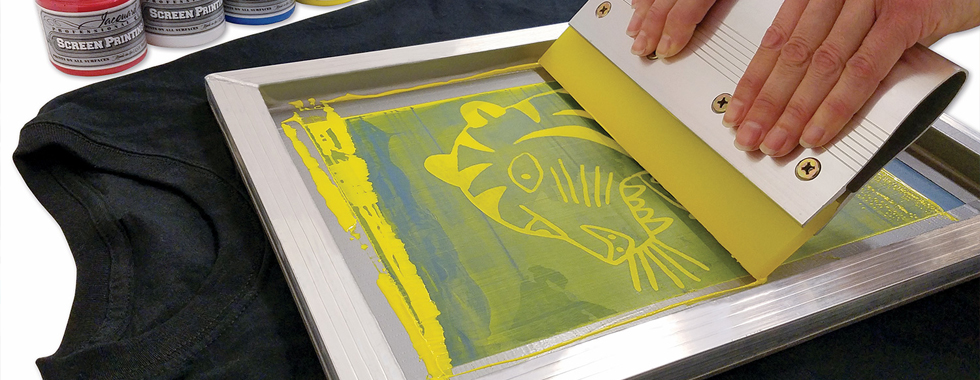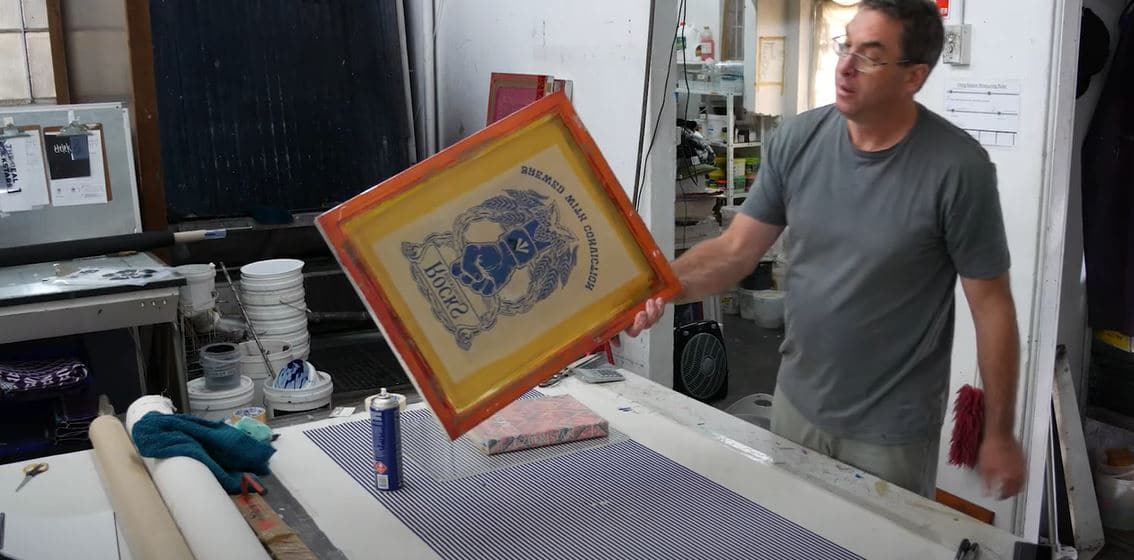ChatGPT said: Why 10:9 Design near me is the most reliable for local customers
Discover the Various Kinds Of Screen Printing Techniques for Your Following Task
Screen printing supplies a diverse array of techniques that can boost any innovative project. From standard techniques like serigraphy to modern developments such as direct-to-garment printing, each technique has its one-of-a-kind benefits. Specialty choices, consisting of metal and environment-friendly inks, present even more possibilities. Recognizing these methods can considerably influence the final end result. Nevertheless, the challenge lies in selecting the most appropriate approach for details demands and desired results. What elements should one consider?

The Essentials of Screen Printing
Although screen printing might seem complex, it is essentially a simple process that includes moving ink with a mesh screen onto various surfaces. The strategy starts with the development of a stencil, which specifies the design to be published. This pattern is connected to a mesh screen, commonly made from polyester or nylon. When the pattern remains in location, ink is put on the screen and pressed via the mesh using a squeegee, resulting in the wanted pattern being published on the underlying product.
Screen printing can be carried out on a vast array of substrates, consisting of textile, paper, and plastic, making it a versatile option for different jobs. The process enables for complex designs and vibrant shades, making it popular in sectors such as marketing, style, and art. Comprehending these fundamentals gears up people with the foundational knowledge called for to explore even more sophisticated methods in screen printing.
Typical Screen Printing Techniques
Typical screen printing techniques have actually been used for centuries, preserving the workmanship and virtuosity of this technique. This method utilizes a mesh screen to move ink onto a substrate, such as textile or paper, permitting for dynamic and long-lasting layouts. The procedure begins with developing a pattern, which blocks specific areas of the screen to regulate where the ink will be used.
One preferred technique is serigraphy, commonly made use of for minimal editions and artistic prints. One more is using water-based inks, which are eco-friendly and offer a soft feeling on fabrics - 10:9 Design reviews. In addition, traditional methods can include manual printing, where artisans apply ink with a squeegee, guaranteeing precision and interest to detail
These techniques remain valued in the market for their tactile quality and the distinct textures they produce, appealing to both consumers and creators who value the heritage of screen printing.
Digital Screen Printing Innovations
As the need for faster manufacturing and modification in the printing market has surged, digital screen printing advancements have actually become a game-changer. This innovation blends conventional screen printing techniques with digital processes, enabling quick prototyping and complex styles that were previously difficult to attain. One significant development is the intro of direct-to-garment (DTG) printing, which facilitates high-quality, full-color prints on numerous fabrics without the need for displays. Furthermore, developments in ink formulations have actually resulted in eco-friendly alternatives that preserve vibrant shades while minimizing ecological impact. The usage of automated systems additionally streamlines manufacturing, reducing labor expenses and enhancing accuracy. These innovations not just satisfy tiny batch orders and individualized layouts however also permit quicker turn-around times, making them excellent for companies concentrated on conference client demands in a hectic market. Digital screen printing, consequently, represents an essential development in the domain name of printing techniques.
Specialty Screen Printing Approaches
Exploring specialty screen printing approaches discloses a diverse variety of strategies that press the boundaries of imagination and capability in the printing sector. Among these, glow-in-the-dark inks offer an one-of-a-kind visual effect, making styles come to life in low-light problems. Metal inks, recognized for their shimmering finish, add a touch of luxury to printed materials. One more cutting-edge method is discharge printing, which gets rid of color from the textile rather of adding ink, resulting in a soft, vintage feel. High-density printing creates a raised texture on why not find out more the surface, improving tactile interaction. Furthermore, water-based inks are getting popularity for their lively colors and decreased environmental effect. Each of these specialty techniques deals with specific design demands, making it possible for brands and artists to create standout items that reverberate with their target markets. By leveraging these techniques, companies can elevate their screen printing projects to brand-new elevations, making sure unforgettable impressions.
Eco-Friendly Screen Printing Options
Environment-friendly screen printing choices are gaining grip as the sector moves in the direction of sustainability. Sustainable ink choices and the use of naturally degradable products are vital parts in minimizing the environmental influence of the printing procedure. By adopting these techniques, screen printers can add to a more lasting future while preserving premium results.
Lasting Ink Choices

Biodegradable Products Usage
As the screen printing market develops, the unification of eco-friendly products is ending up being progressively crucial for ecologically mindful practices. Developers and manufacturers are now discovering inks and substratums made from all-natural, renewable energies that decompose more successfully than typical equivalents. These eco-friendly alternatives reduce plastic waste and reduce ecological effect, straightening with pop over to these guys the growing demand for lasting items.
Usual examples include water-based inks and organic cotton materials, both of which lessen hazardous chemicals and advertise eco-friendliness. Brands that take on these products frequently boost their market allure, attracting customers who focus on sustainability. As recognition of environmental issues remains to rise, the shift in the direction of biodegradable materials in screen printing is most likely to obtain energy, cultivating a greener sector requirement.
Selecting the Right Method for Your Project
How can one identify the most ideal screen printing strategy for a certain job? The decision rests on numerous variables, consisting of the product to be printed on, the intricacy of the style, and the preferred production quantity - 10:9 Design near me. For example, direct-to-garment printing is perfect for intricate layouts with many colors, while standard screen printing excels for bigger runs of easier graphics
In addition, consideration of the end-use of the published item is crucial. For outside applications, techniques that use resilience and climate resistance, such as plastisol ink, might be preferred. Alternatively, environmentally-conscious projects may take advantage of water-based inks or biodegradable products.
Eventually, recognizing the project's special needs enables an educated selection, ensuring both aesthetic charm and useful longevity. By assessing style intricacy, product compatibility, and manufacturing scale, one can efficiently choose one of the most ideal screen printing strategy to meet their job's objectives.
Frequently Asked Concerns
What Is the Background of Screen Printing?
Screen printing came from ancient China around 1000 AD, developing with Japan and Europe. By the 20th century, it ended up being preferred in business art and style, changing just how layouts were generated and dispersed around the world.

Just how Do I Prepare Artwork for Screen Printing?
To prepare artwork for screen printing, one need to assure high resolution, use an appropriate shade setting, create separate layers for every shade, and transform text to describes, ensuring compatibility with the printing procedure and desired result.
What Products Are Ideal for Screen Printing?
The very best materials for screen printing include top quality inks, long lasting displays, and ideal substratums like cotton, polyester, or blends. Additionally, using suitable emulsion and squeegees can improve the printing process and results.
Can I Screen Print in your home?
Yes, screen printing in your home is feasible. With the ideal products, arrangement, and strategies, people can produce high-grade prints. However, careful factor to consider of office and devices is crucial for effective outcomes.

What Are Usual Blunders in Screen Printing?
Usual mistakes in screen printing consist of inappropriate exposure times, inadequate ink consistency, misalignment of screens, inadequate cleansing of products, and ignoring to examine prints. These mistakes can compromise the quality and accuracy of the final product.
Screen printing may seem complex, it is essentially a simple process that includes transferring ink with a mesh screen onto different surfaces. As the demand for faster production and customization in the printing industry has actually risen, electronic screen printing advancements have actually emerged as a game-changer. Checking out specialty screen printing methods reveals a varied variety of methods that push the boundaries of creativity and functionality in the printing sector. The ideal materials for screen printing include top quality inks, durable displays, and appropriate click over here substrates like cotton, polyester, or blends (10:9 Design Abilene). Usual errors in screen printing consist of improper direct exposure times, insufficient ink consistency, imbalance of screens, not enough cleaning of materials, and disregarding to check prints